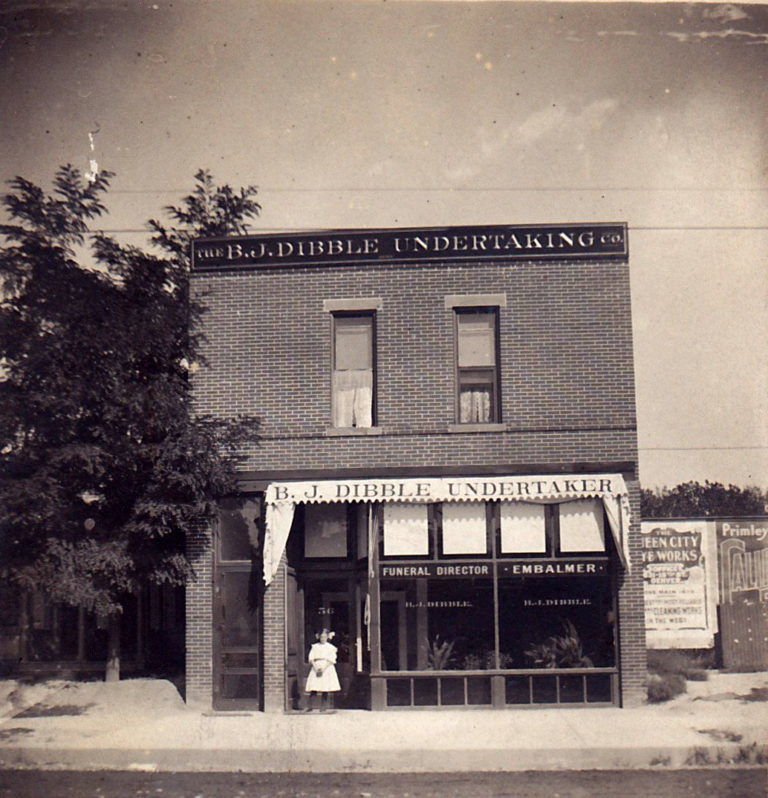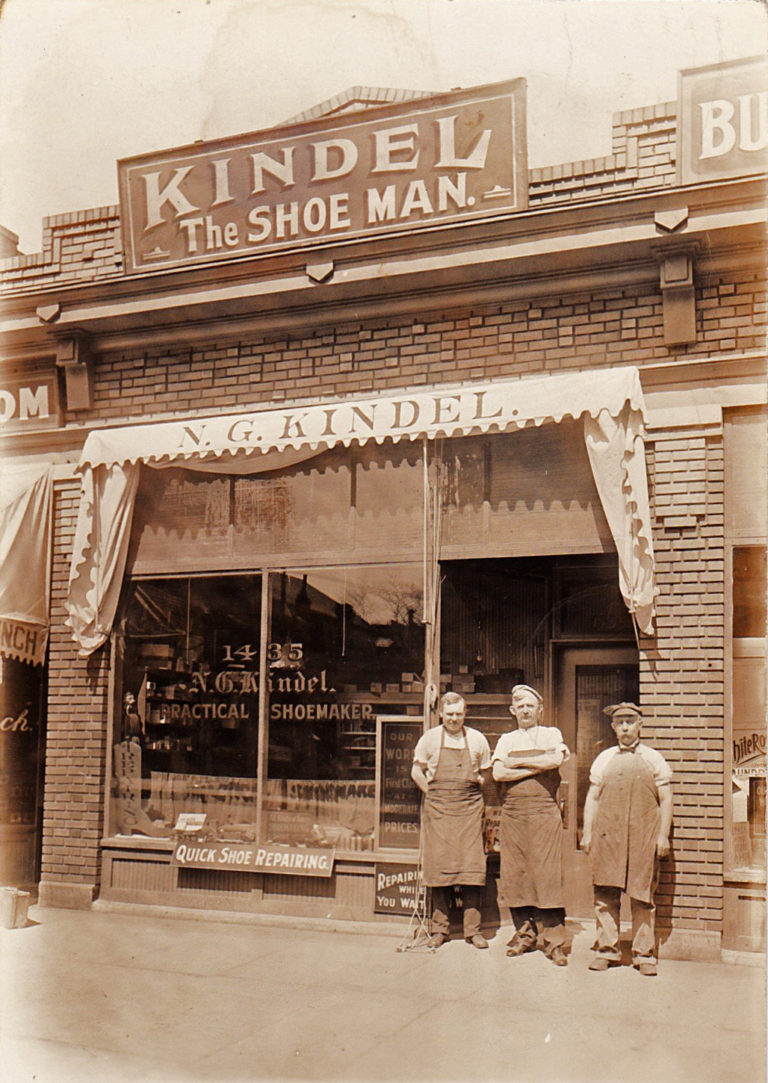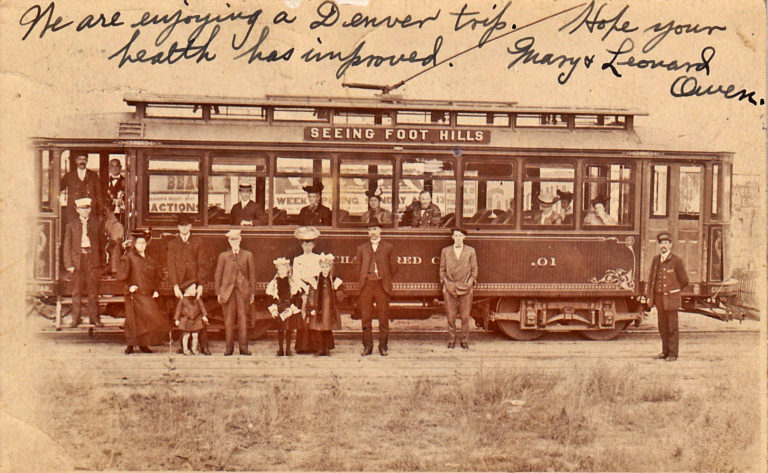This unmailed photo postcard shows two horses on a wooden-slatted treadmill connected via belt and pulley to a water pump. A treadmill used in such a way to power another machine is an example of what’s called a horse engine.
“Mary” writes on the back of the postcard, “The horse with the mule face is George’s pony. The other is one that takes me too (sic) the hospital most every day.” Written in another hand on the back is, “Watering the lambs – Horses forcing it to place.” You can see sheep through the fencing at right. I studied the name in the upper left-hand corner of the photo, and, except for the name “Mary and the initial “K,” could not figure out the surname, even though I entered various spellings. The photo notation in the upper right corner identifying the farm as “in Denver Colorado,” clearly seems to speak to a more agrarian time.
The animal-powered treadmill reportedly was invented in England in 1823. Depending on the need, treadmills have been operated by a variety of animals through the years, including oxen, goats, dogs and sheep. One farmer in Northern Ireland built a treadmill to be operated by a cow to power milking machines. In 1908, a farmer in New Jersey used his bull on a treadmill to pump water, churn butter and perform other tasks.
There were of course mishaps involving animals on treadmills. In 1908, sixteen oxen working a treadmill for a cotton gin in Viola, Arkansas, suddenly broke into a gallop. The newspaper reporting the story said the “gin roared like a western cyclone, the excited populace of the town appeared awe-stricken, and pandemonium reigned…There were no air brakes, nothing to check the awful speed, and the operators were dumbfounded.” Measures taken to stop the runaway treadmill included the throwing of “heavy weights” on it and filling the cogs with gravel, but none were successful until “an old lady suggested a tub of salty water be prepared and that a bucketful of the brine be thrown in the face of each turbulent bovine.” This measure succeeded in quelling the stampede.
Mishaps could also prove fatal, such as the one in 1903 that befell Patronious, a 6-year-old thoroughbred Percheron-Norman stallion valued at $400. His owner, R. A. Chace, a rancher and farmer outside of Fort Morgan, was working the horse on a treadmill, most likely for fitness and conditioning, when one or more slats of the treadmill broke. Before Chace could stop the treadmill, it fractured one of Patronious’ hind legs so severely fractured that he had to be put down.
Treadmills for animals are still in use today. Athens Treadmills manufactures one- and two-horse treadmills in Tennessee, serving a customer base which includes the Amish or other Plain communities. (Plain people are Christian groups who choose to be separate from the world, including its electrical power grid, and whose customs include plain dress and plain or no church buildings.) For these communities, the treadmills serve to exercise their horses and at the same time create power ranging from 1/3 to 1 ½ horsepower. This is power sufficient to run machines and equipment such as water pumps, washing machines, wood splitters and a variety of air tools.
REFERENCES:
- “Animal power was a progression in time,” by Sam Moore, dated January 4, 2018, FARM and DAIRY at https://www.farmanddairy.com/columns/animal-power-was-a-progression-in-time/463947.html
- “The Economical Equine: How Horse Treadmills Became a (Very) Niche Thing,” by Anna O’Brien, MODERN FARMER dated January 13, 2015, at https://modernfarmer.com/2015/01/economical-equine-horse-treadmills-became-niche-thing/
- “Has Trained Bull at Work,” The Statesman (Denver), November 7, 1908, Colorado Historic Newspapers Collection, at www.coloradohistoricnewspapers.org/
- “Horse engine,” Wikipedia.org at https://en.wikipedia.org/wiki/Horse_engine
- “Horse Treadmill Provides Power And Exercise,” FARM SHOW, 2019, at https://www.farmshow.com/a_article.php?aid=34875
- “Of a Local Nature,” The Fort Morgan Times, dated April 3, 1903, Colorado Historic Newspapers Collection, at www.coloradohistoricnewspapers.org/
- “Oxen on a Rampage,” The Newspaper (Paonia), dated January 31, 1908, Colorado Historic Newspapers Collection, at www.coloradohistoricnewspapers.org/
- “Patronious,” The Fort Morgan Times, dated April 25, 1902, Historic Newspapers Collection at www.coloradohistoricnewspapers.org/
- “Plain people,” Wikipedia.org at https://en.wikipedia.org/wiki/Plain_people
- “Slater the Traitor & America’s Industrial Revolution,” cartB4thehorse blog dated March 23, 2017, at http://www.craigphoward.com/tracesofhistory/2017/3/23/slater-the-traitor-and-americas-industrial-revolution#:~:text=With%20capital%20from%20Quaker%20Moses,a%20treadmill%20to%20supply%20power.&text=The%20gin%20allowed%20more%20cotton,to%20be%20turned%20into%20thread.
- 1900 Census (www.ancestry.com)




